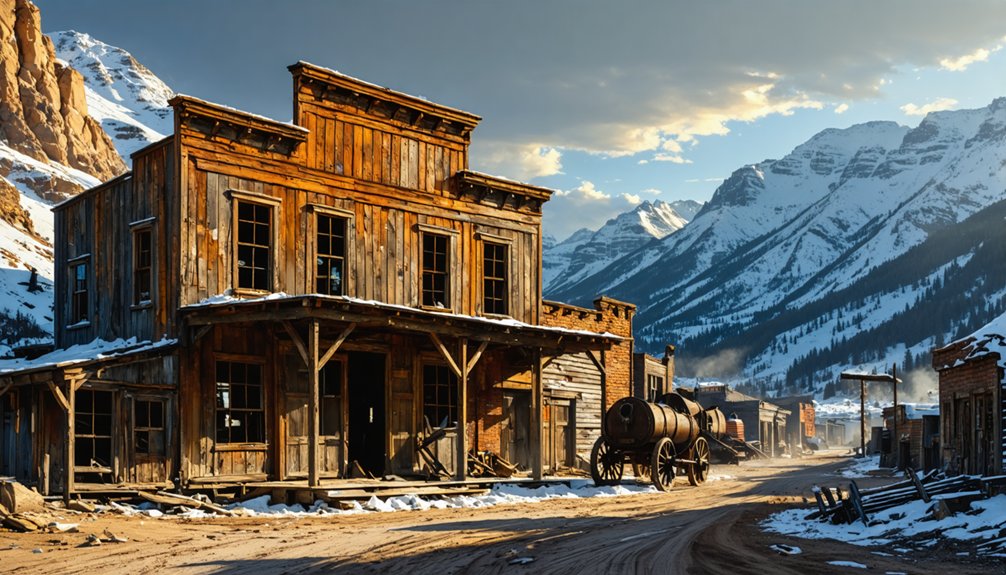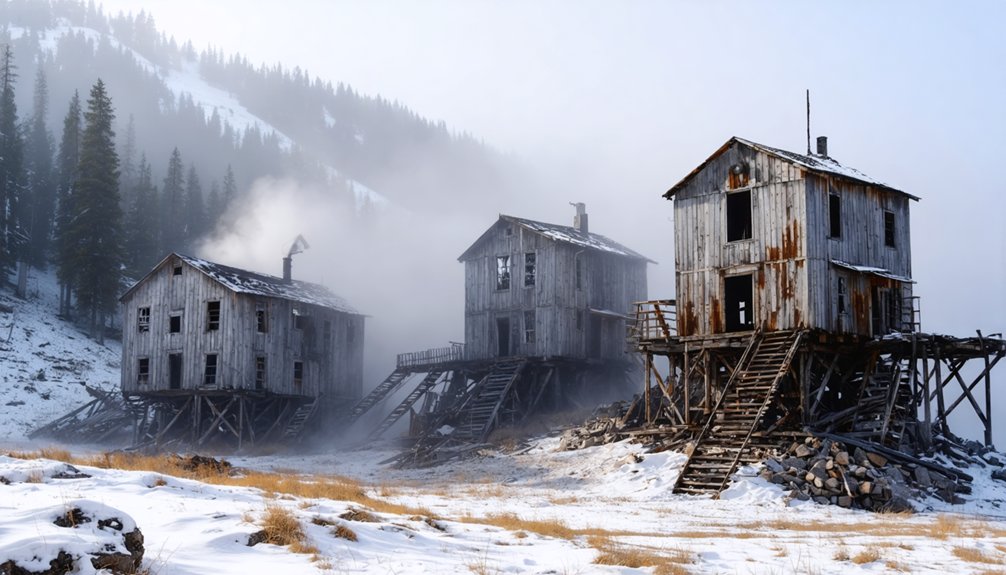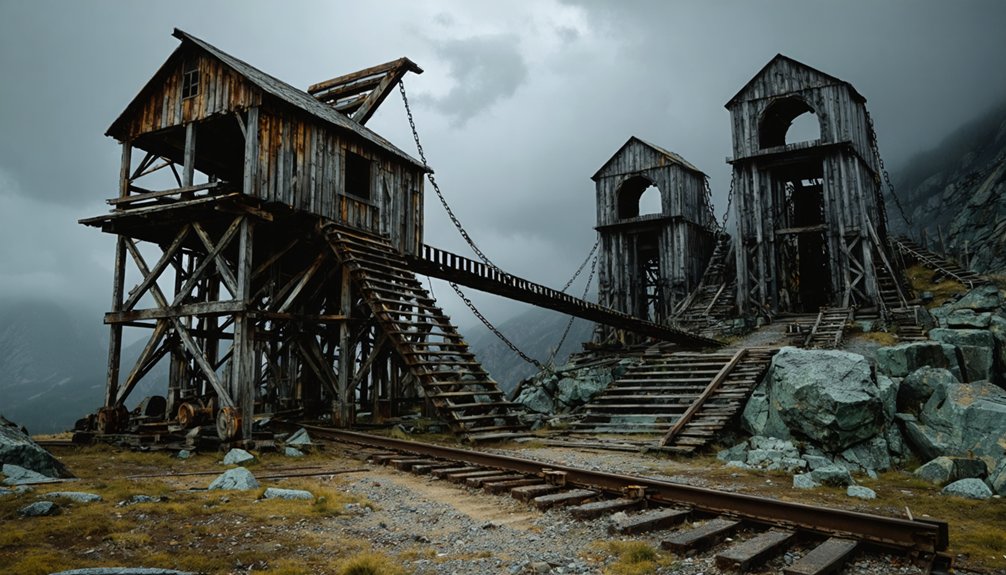Colorado’s silver boom left behind eerie mining ghost towns that tell tales of prosperity and collapse. You’ll find Independence Pass with its weathered cabins at 10,900 feet, Saint Elmo with its preserved storefronts, Animas Forks perched at a challenging 11,200-foot elevation, and Teller City with remnants of 27 saloons. These abandoned settlements reveal Colorado’s boom-and-bust mining heritage with each crumbling structure holding stories of frontier ambition.
Key Takeaways
- Independence Ghost Town stands frozen in time at 10,900 feet elevation with weathered log cabins and interpretive trails.
- Saint Elmo maintains its original wooden storefronts and operates a general store despite the railroad’s 1922 departure.
- Animas Forks preserves nine structures at 11,200 feet, making it one of North America’s highest abandoned mining settlements.
- Teller City once boasted over 27 saloons and 1,500 residents before completely collapsing after the 1893 silver crash.
- The 1893 silver market devaluation devastated Colorado’s mining towns, transforming thriving communities into abandoned ghost towns.
Silver Boom to Environmental Disaster: The Rise and Fall of AbandonedSilver
While Colorado’s mining history began with the gold rush of 1858, it was the subsequent silver discoveries that transformed the landscape and economy of the state.
You’d have witnessed boomtowns like Gilman, Ashcroft, and Ironton springing up almost overnight in the 1870s and 1880s, particularly in the San Juan Mountains.
These silver mining communities flourished briefly—some reaching populations over 1,500—before collapsing when silver was devalued in 1893.
Colorado’s silver boomtowns blazed brightly but briefly, extinguished by the economic crash of 1893.
The aftermath wasn’t just economic devastation but environmental ruin. By 1984, the EPA ordered Gilman’s complete evacuation due to toxic contamination from flooded mines.
Today, these ghost towns stand as stark reminders of both Colorado’s rich mining heritage and the lasting environmental wounds left behind when prosperity abandons a place. Of the more than 1,500 ghost towns throughout Colorado, approximately 640 have structures still visible to modern-day explorers. Gilman specifically operated for an impressive 99 years before economic and environmental factors forced its closure.
Independence Pass: A High-Altitude Ghost Town Frozen in Time
Perched at a breathtaking 10,900 feet on Independence Pass, the ghost town of Independence stands as Colorado’s quintessential boom-and-bust mining tale.
You’ll be walking through America’s mining legacy when visiting this site, first discovered on July 4, 1879, triggering the Roaring Fork Valley’s first gold rush.
The town’s ghost town history reveals a meteoric rise—reaching 1,500 residents by 1882 with over 40 businesses flourishing as miners extracted $190,000 in gold.
But prosperity proved fleeting. By 1888, fewer than 100 people remained, and the devastating winter storm of 1899 forced the final residents to fashion makeshift skis and flee to Aspen.
The Aspen Historical Society now offers guided summer tours of this historic site for visitors interested in learning about Colorado’s mining history.
Today, you’ll find only weathered log cabins and interpretive trails telling the story of this high-altitude settlement, accessible only during summer months. Visitors can explore the remaining structures including a stable, general store, two boarding houses, and the historic Farwell Stamp Mill which represent the town’s mining heritage.
Saint Elmo: the Well-Preserved Mining Settlement With Operating General Store
Unlike Independence Pass’s isolated ruins, Saint Elmo offers visitors a rare glimpse into Colorado’s mining past where history still breathes. Founded in 1880 near the Mary Murphy Mine, this remarkably intact ghost town preservation success story once thrived with 2,000 residents during its 1880s silver boom.
You’ll walk the same dirt streets where miners once bustled between hotels, restaurants, and businesses. Despite declining after the railroad’s 1922 departure and the Mary Murphy Mine’s 1936 closure, Saint Elmo avoided total abandonment.
The town’s wooden storefronts and original architecture remain largely intact, earning it a spot on the National Register of Historic Places. Visitors can enhance their experience by exploring interpretive kiosks that provide detailed information about building histories and restoration techniques throughout the town.
What truly sets Saint Elmo apart in Colorado’s mining history is its functioning general store, still serving visitors much as it did during the boom years. Saint Elmo experienced a brief revival in the 1910s when new ore discoveries breathed life back into the mining industry.
Animas Forks: Where Avalanches and Extreme Elevation Claimed a Community
At 11,200 feet above sea level, Animas Forks stands as one of North America’s highest mining settlements, where the harsh realities of mountain life shaped every aspect of its dramatic history.
Established in 1873 after gold and silver discoveries, this mining heritage site quickly flourished with over 450 residents by the 1870s, complete with saloons, a newspaper, and modern amenities.
The town’s extreme elevation created unique challenges, including avalanche risks that threatened structures and lives. The town boasted over 30 cabins alongside a hotel, drug store, and local post office during its heyday.
Despite technological advances like electricity and telephones by 1905, Animas Forks couldn’t survive the 1891 fire, 1893 silver market crash, and the Gold Prince Mill’s closure in 1910.
Today, you’ll find nine weathered wooden structures standing among alpine meadows, preserved on the National Register of Historic Places. Visitors can explore the restored Duncan House with its distinctive bay windows that represented luxury in this remote mining community.
The Lost Saloons of Teller City: North Park’s Forgotten Silver Boom
When silver was discovered in the remote North Park region in 1879, Teller City erupted from the wilderness with remarkable speed, transforming from an untouched forest into Grand County’s largest settlement within months.
At its peak, over 1,500 residents called this boomtown home, with more than 27 saloons lining the streets—lost establishments that once buzzed with miners’ tales and frontier dreams.
The impressive 40-room Yates House Hotel anchored a community complete with newspapers, a doctor, and various businesses. Named after U.S. Senator Henry Teller, a strong advocate for silver mining, the town’s rapid growth symbolized the high hopes of the Colorado silver rush.
The town’s first official document was recorded by Mador Kushman, the founder who established Teller City and initiated its brief but vibrant chapter in Colorado’s mining history.
Frequently Asked Questions
Are There Paranormal Activities Reported in These Abandoned Mining Towns?
Yes, you’ll find abundant paranormal activities with ghost sightings reported in these towns. You’ll encounter haunted tales of spectral miners, unexplained sounds, and mysterious temperature drops throughout these historic locations.
Can Visitors Take Artifacts or Souvenirs From These Historic Sites?
No, you can’t take artifacts. It’s illegal with serious legal consequences. Artifact preservation is protected by Colorado law, and removing items damages historical context for future explorers to enjoy.
What Wildlife Dangers Exist When Exploring Colorado Ghost Towns?
Beware the silent predators lurking in shadows! You’ll face potential wildlife encounters with mountain lions, bears, snakes, and disease-carrying small mammals. Always maintain distance and take safety precautions when exploring these wilderness-reclaimed structures.
Are Any Abandoned Mining Towns Available for Purchase or Development?
While you’ll find few complete towns for sale, individual properties with development potential exist. Real estate opportunities are limited by historical protections, unstable mine shafts, and environmental regulations affecting your redevelopment freedom.
How Accessible Are These Sites for Visitors With Mobility Limitations?
Most sites offer limited wheelchair access due to unpaved streets and rough terrain. You’ll face challenges with uneven trail conditions, lack of ramps, and high-altitude locations requiring significant physical navigation.
References
- https://en.wikipedia.org/wiki/List_of_ghost_towns_in_Colorado
- https://www.youtube.com/watch?v=CCXuJJiQDfA
- https://www.colorado.com/articles/colorado-ghost-towns
- https://www.youtube.com/watch?v=NRfs_IwOalQ
- https://www.youtube.com/watch?v=SXVTtQjK8lU
- https://www.youtube.com/watch?v=wpWoIJmbUy4
- https://www.uncovercolorado.com/ghost-towns/
- https://archives.colorado.gov/collections/historic-mine-reports
- https://www.americansky.co.uk/colorado-holidays/exploring-colorados-ghost-towns
- https://www.businessinsider.com/?is_retargeting=true&af_ss_ver=2_3_0&c=post_page_share_bar_v2_smart_4.13.23&pid=businessinsider&deep_link_value=https://www.businessinsider.com/abandoned-boston-mine-ghost-town-colorado-photos-2022-10&af_js_web=true&af_force_deeplink=true



